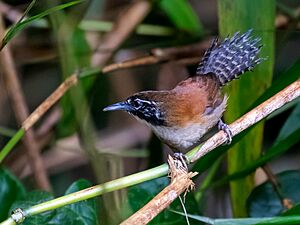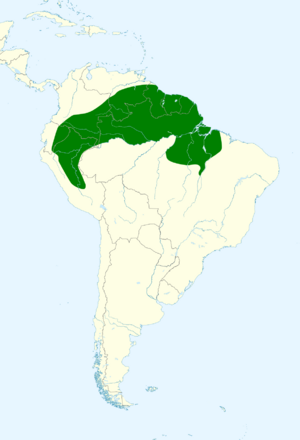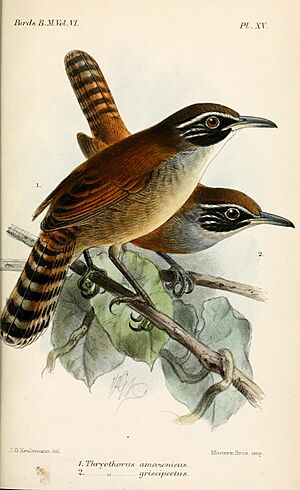Coraya wren facts for kids
Quick facts for kids Coraya wren |
|
|---|---|
 |
|
| Conservation status | |
| Scientific classification | |
| Genus: |
Pheugopedius
|
| Species: |
coraya
|
 |
|
| Synonyms | |
|
Thryothorus coraya |
|
The coraya wren (Pheugopedius coraya) is a small, active bird that belongs to the wren family, called Troglodytidae. These birds are known for their lively songs and often live in thick forests. You can find the coraya wren in parts of South America, especially around the Amazon River basin.
Contents
About the Coraya Wren's Name
The coraya wren was first officially described in 1789. A German scientist named Johann Friedrich Gmelin gave it its scientific name. He put it in a group of birds called Turdus at first. Later, it was moved to the Pheugopedius group, which is where it is today.
The name "coraya" comes from a French phrase, queue rayée. This means "barred tail," which describes the bird's striped tail.
Different Types of Coraya Wrens
Scientists have found ten different types, or subspecies, of the coraya wren. These subspecies are slightly different from each other. They often live in different areas.
Here are the ten subspecies:
- P. c. obscurus – found in eastern Venezuela
- P. c. caurensis – found in eastern Colombia, southern Venezuela, and northwest Brazil
- P. c. barrowcloughianus – found in southeast Venezuela
- P. c. ridgwayi – found in northeast and eastern Venezuela, and western Guyana
- P. c. coraya – found in the Guianas (Guyana, French Guiana, Suriname) and northern Brazil
- P. c. herberti – found in northeast Brazil, south of the Amazon River
- P. c. griseipectus – found in eastern Ecuador, northeast Peru, and western Brazil
- P. c. amazonicus – found in eastern Peru
- P. c. albiventris – found in northern Peru
- P. c. cantator – found in central Peru
Where Coraya Wrens Live
The coraya wren lives in northern and northwestern South America. This includes the northern Amazon Basin and a region called the Guianas. You can find them in countries like Guyana, French Guiana, and Suriname. They also live in parts of Colombia, Ecuador, and Peru.
Their Home Environment
These wrens prefer certain types of places to live. Their natural habitats are:
They are often found near the Amazon River and its many branches. They can even be seen on Ilha de Marajo, an island at the mouth of the Amazon River.
What Coraya Wrens Look Like
The coraya wren is a medium-sized wren. It has a reddish-brown body, especially on its back. Its tail is a medium length and has black and white stripes.
Key Features
- Head: It has a black head with small white spots.
- Eyes: There's a bright white stripe just above its eye. It also has a thin ring of white feathers around its eye.
- Throat and Chest: Its throat is white, and its chest is a creamy white color.
- Bill: The bill (beak) is black and curves slightly downwards.
- Legs: Its legs are gray-black.
- Wings and Sides: The wings are a deep brownish-black. Its sides are a lighter, buff brown.



